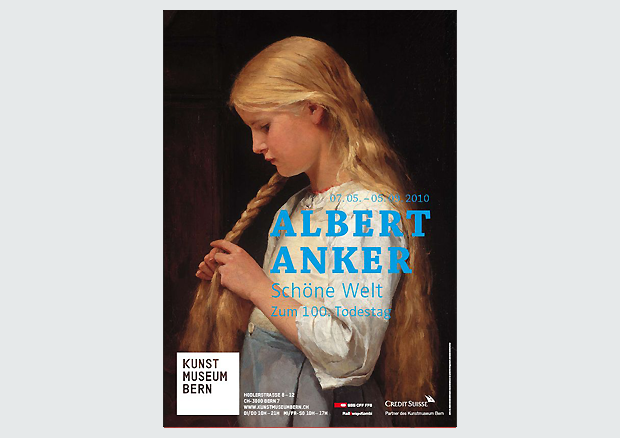Albert Anker. Beautiful World – On the Centenary of His Death and Chantal Michel – Honey, Milk And First Violets. An Artistic Response to Albert Anker, 07.05 - 05.09.2010
Close Contact to Fellow Human Beings
The Kunstmuseum Bern is putting on a large retrospective of Albert Anker's manifold oeuvre to commemorate the centenary of this key Swiss artist's death. The exhibition will take up several themes representative for Anker's work and demonstrate how exceptional he was as a painter. Video works by Chantal Michel, a performance and media artist who lives in Bern, enhance the presentation.
A trigger for this exhibition was the immensely popular
Anker show that was organized by the Kunstmuseum Bern in 2007-2008 for
four Japanese Museums. The works on show comprise paintings, drawings,
watercolors, and faiences. The exhibition is undoubtedly a highlight in
the year of celebrations concerning the centenary of Anker's death.
Photographic precision
Anker depicted the world with photographic precision. As a painter he
witnessed the social changes of his times. Ins, a village in Seeland,
was his hometown. It underwent extensive development in the 19th
century. He actively participated in Ins community life throughout his
life, even if he preferred, over a longer period of time, to live and
work in Paris during the winter months. Very often he recorded
unspectacular moments in the unencumbered intergenerational communal
life in the village. Many of his paintings depict children attending
school, on school excursions, or while doing their homework or at play.
Anker was well-acquainted with the education system and for many years
worked as secretary for the Ins school commission. As a result his
paintings reflect the developments of the education system in
Switzerland and communicate the new understanding of raising children,
educating them, and learning through playing and games.
People and Rural Life
Sharing his day-to-day life with the people he portrayed, Anker showed
great empathy for his sitters. Especially his portraits of children are
unique in 19th-century art. He comprehended children as little
personalities and independent of the roles dictated by their social
class, age, and gender. Also his still lifes evidence the proximity of
human presence in a variety of ways, for example, by traces of usage on
the represented objects. Anker's images definitely win our credibility
and appear somehow familiar. Truth and beauty are not contradictory in
his eyes. His close contact to his fellow human beings makes his
intimate and light-bathed realism still moving for viewers today.
A Contemporary Dream by Chantal Michel
Chantal Michel bridges the gap to contemporary times. The Bernese
performance and media artist has taken up the challenge of finding an
appropriate contemporary response to the old master of Swiss art
history. Chantal Michel has long focused intensively on Anker. She
comprehends the video installation she created especially for the Anker
exhibition as a "contemporary dream within the world of Anker's
imagery". The installation comprises six projections of forty different
video sequences in total.


